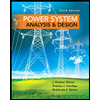
Delmar's Standard Textbook Of Electricity
7th Edition
ISBN: 9781337900348
Author: Stephen L. Herman
Publisher: Cengage Learning
expand_more
expand_more
format_list_bulleted
Concept explainers
Textbook Question
Chapter 17, Problem 1RQ
What is the relationship of voltage and current (concerning phase angle) in a pure resistive circuit?
Expert Solution & Answer
To determine
The phase relationship of voltage and current in a pure resistive circuit.
Answer to Problem 1RQ
Zero degrees
Explanation of Solution
When an AC voltage is applied to a resistor, the current rises and falls at the same rate as the voltage. The polarities are also maintained when the directions are reversed. Hence the voltage and current in a resistor are said to be in phase. The degrees by which current and voltage are out of phase with each other is said to be zero degrees in this case.
Want to see more full solutions like this?
Subscribe now to access step-by-step solutions to millions of textbook problems written by subject matter experts!
Students have asked these similar questions
Don't use ai to answer I will report you answer
help on this question about three-phase half-wave rectifier? Also it envolves a little bit of signals and systems.
Don't use ai to answer I will report you answer
Chapter 17 Solutions
Delmar's Standard Textbook Of Electricity
Ch. 17 - 1. What is the relationship of voltage and current...Ch. 17 - What is the relationship of voltage and current...Ch. 17 - 3. What is power factor?
Ch. 17 - 4. A circuit contains a 20- resistor and an...Ch. 17 - 5. An R-L series circuit has a power factor of...Ch. 17 - 6. An R-L series circuit has an apparent power of...Ch. 17 - 7. The resistor in an R-L series circuit has a...Ch. 17 - 8. An R-L series circuit has a reactive power of...Ch. 17 - 9. An R-L series circuit contains a resistor and...Ch. 17 - 10. What is the voltage drop across the resistor...
Ch. 17 - 11. A phase angle meter connected in an R-L series...Ch. 17 - 12. An R-L series circuit has a power factor of...Ch. 17 - An AC electric motor is connected to a 240-V,...Ch. 17 - You are a journeyman electrician working in an...Ch. 17 - Assume that the circuit shown in Figure 17-2 is...Ch. 17 - Assume that the voltage drop across the resistor,...Ch. 17 - Assume the circuit shown in Figure 17-2 has an...Ch. 17 - Assume the circuit shown in Figure 17-2 has a...Ch. 17 - In an R-L series circuit,...Ch. 17 - In an R-L series circuit,...Ch. 17 - In an R-L series circuit,...Ch. 17 - In an R-L series circuit, the apparent power is...Ch. 17 - 9. An R-L series circuit is connected to a 60-Hz,...Ch. 17 - In an R-L series circuit, Z=88,R=32.FindXL.Ch. 17 - In an R-L series circuit, apparent power = 450 VA,...Ch. 17 - In an R-L series circuit, =22, true power = 94...Ch. 17 - An R-L series circuit contains two resistors and...Ch. 17 - An R-L series circuit contains two resistors and...Ch. 17 - An R-L series circuit contains two resistors and...Ch. 17 - An R-L series circuit contains two resistors and...
Knowledge Booster
Learn more about
Need a deep-dive on the concept behind this application? Look no further. Learn more about this topic, electrical-engineering and related others by exploring similar questions and additional content below.Similar questions
- Correlation of experimental data for the average heat transfer coefficient for turbulent flow through tubes is given by NUD =hD/k=0.023 (Rep) 0.8 (Pr) 1/3 The Reynolds number, Re₁ = πD/v, is based on the tube diameter D, the average flow velocity ū and the kinematic viscosity v. Consider the flow of air and of water through tubes of identical size. Assume that the average velocity is the same for both fluids. If the average temperature for both fluids is 80°C, determine the ratio of the heat transfer coefficient of water to that of air.arrow_forwardDon't use ai to answer I will report you answerarrow_forwardDon't use ai to answer I will report you answerarrow_forward
- help on questions about singals and systems?arrow_forwardDon't use ai to answer I will report you answerarrow_forwardI have this code in matlab: clc; n=0:8; %20 harmonic indices jn=besselj(n,5);% 5 is the modulation index jnn=abs(jn); jn1 = 20.*log10(jnn*0.5); fc=1e+6; %carrier frequency fm=10e+3; %message frequency frq1 = (fc+n.*fm)*1e-06; frq2 = (fc-n.*fm)*1e-06; frequencies = [frq2,frq1]; %Lower and upper side magnitudes = [jn1,jn1]; %Magnitude of Jn corresponding to the frequencies % Plot figure; stem(frequencies, magnitudes, 'filled'); % Stem plot for spectrum visualization title('Magnitude Spectrum of FM Signal'); xlabel('Frequency (MHz)'); ylabel('Magnitude'); grid on; I am getting the lines opposite (the line should be traced from bottom to top not from top to bottom) as shown in the picture. How can I fix this?arrow_forward
- Don't use ai to answer I will report you answerarrow_forward.I need in the way of spaces and not in shortened ways A 3-phase, 50 Hz, 132 kV overhead line transpose system of bundle conductors .a radius of conductor is 0.5 cm Calculate the total inductance of the line.) bi 4m C1 al 4m m birarrow_forward1B) Suppose the flip-flops are 74F74 devices and the AND gates are 74F08 devices. Let maxtpd,D=9ns, maxtsu,D=3ns, and maxtpd,AND=6ns. What is the maximum clock frequency at which the circuit can operate reliably? 2) Compare serial transmission and parallel transmission and discuss their advantages and disadvantages. 3) Explain briefly how the slave can protect itself from being overwhelmed by the master in I2 4) A hypothetical logic family has the following specifications. VOH=4.6V VIH=4.0V VOL=0.5V VIL=1.0V IOH=-1mA IIH=50μA IOL=8mA IIL=-0.6mA (4a) What are the noise margins? (4b) What is the fan-out capability? That is, suppose all gates are chosen from the same logic family, how many gates can an output gate reliably drive? 5) Explain briefly why USB device address and…arrow_forward
- can you drow set Vi=0, set Vo=0 B. For the FET amplifier circuit of Fig.(2), determine the topolgy, and the gain without and with feedback with the following circuit values: rao, and g 4mS Is Voo 60 K www 100 K 0.25 K IK Fig.(2) 20 K ww Voarrow_forwardcan you draw acircuit For the feedback circuit shown below VDD Set Vico set Vo=0 Is 100 K 26 K 2 K Q1 76 K IF 60 K 40 K Voarrow_forwardThe previous solutions are incorrect and unclear. If possible, please solve the question on the images .clearly. Thank you A 3-phase, 50 Hz, 132 kV overhead line transpose system of bundle conductors .a radius of conductor is 0.5 cm. Calculate the total inductance of the line. bi 4m m im birarrow_forward
arrow_back_ios
SEE MORE QUESTIONS
arrow_forward_ios
Recommended textbooks for you
 Delmar's Standard Textbook Of ElectricityElectrical EngineeringISBN:9781337900348Author:Stephen L. HermanPublisher:Cengage Learning
Delmar's Standard Textbook Of ElectricityElectrical EngineeringISBN:9781337900348Author:Stephen L. HermanPublisher:Cengage Learning Power System Analysis and Design (MindTap Course ...Electrical EngineeringISBN:9781305632134Author:J. Duncan Glover, Thomas Overbye, Mulukutla S. SarmaPublisher:Cengage Learning
Power System Analysis and Design (MindTap Course ...Electrical EngineeringISBN:9781305632134Author:J. Duncan Glover, Thomas Overbye, Mulukutla S. SarmaPublisher:Cengage Learning

Delmar's Standard Textbook Of Electricity
Electrical Engineering
ISBN:9781337900348
Author:Stephen L. Herman
Publisher:Cengage Learning

Power System Analysis and Design (MindTap Course ...
Electrical Engineering
ISBN:9781305632134
Author:J. Duncan Glover, Thomas Overbye, Mulukutla S. Sarma
Publisher:Cengage Learning
Z Parameters - Impedance Parameters; Author: Electrical Engineering Authority;https://www.youtube.com/watch?v=qoD4AoNmySA;License: Standard Youtube License